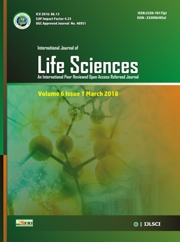RESEARCH ARTICLES
Volume 9 |Issue 2| March-April 2021 First published: 30 April 2021
Consequences of relative humidity (RH%) and temperature on occurrence of storage fungi of niger (Guizotia abyssinica) oil seed
Deshmukh AM
Department of Botony, Pratisthan Mahavidyala , Paithan MS, India
Email: drdeshmukh.a.m@gmail.com
Abstract
Keywords:Niger, Relative humidity, Temperature, Seed borne fungi
Editor: Dr.Arvind Chavhan
Cite this article as:
Deshmukh AM. Consequences of relative humidity (RH%) and temperature on occurrence of storage fungi of niger (Guizotia abyssinica) oil seed, Int. Res. Journal of Science & Engineering, 2021, Volume 9(2): 66-68.
References
1. Agarwal VK, Joshi AB. A Perliminary note on the puple stain disease of soybean. Indian phytopath., 1972; 24(4):810-812.
2. Agarwal VK, Mathur SB and Neergard P. Some aspect of seed health testing greengram with respect to seedborne fungi of rice, wheat, blackgram and soybean grown in India. Indian phytopath. 1972, 25:91-100.
3. Anil kumar TB and Shantha D. Urs. Seed mycoflora of sunflower and its control. Musore J. agric Sci., 1976; 10:424-427.
4. Jhararia SL, Sharma KB and Gupta RBL. Fungi intercepted from sunflower seeds and there control. Indian J. Pl. Port., 1974; 2: 86-88.
5. Kanwar ZS, Khanna PK and Thareha ML. Seed mycoflora of sunflower and there control. Pesticides., 1979; 13(9): 41-43.
6. Nandi D. Mandal GC and Nandi B. Studies on deterioration of some oil seeds in storage. Seed Sci. and tech., 1982; 10(1): 141-150.

